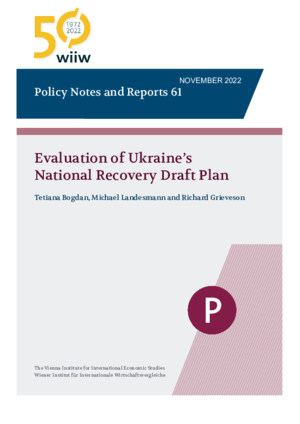Evaluation of Ukraine’s National Recovery Draft Plan
Tetiana Bogdan, Richard Grieveson and Michael Landesmann
wiiw Policy Note/Policy Report No. 61, November 2022
31 pages including 2 Tables and 1 Box
Russia’s invasion of Ukraine has caused human suffering, the destruction of infrastructure and environmental damage on a huge scale. The Ukrainian government has already started to prepare for reconstruction, and presented its National Recovery Plan in July 2022. The plan has many strengths, including a focus on institutional upgrading, reducing the power of oligarchs, accelerating EU integration and convergence with EU standards, and a correct identification of the most pressing short-term measures to support the economy. However, we also identify several shortcomings and areas for improvement. The plan overestimates the cost of reconstruction: we estimate Ukraine’s external financial needs for post-war reconstruction at USD 410bn (without security needs) – somewhat lower than the government’s projection of USD 500bn. We also think that the government overestimates the economy’s post-war growth potential. Adjustments need to be made both to the distribution of post-war financing across sectors and to the plans related to industrial policy and the financial sector. The aspiration to lower the tax burden is unlikely to be compatible with post-war demands on the state budget related to reconstruction. In addition, the proposed decentralised approach is unlikely to yield the best results: in most areas, reconstruction should be guided at the national level. Attention should also be given to the areas of overlap, the lack of coordination between different elements of the reconstruction plan, and, in some cases, the incorrect prioritisation of tasks.
Keywords: Ukraine economic recovery plan, Ukraine economic reconstruction, Ukraine-EU integration, Ukraine financing needs, Ukraine-Russia war, Reconstruction in the Balkan states
JEL classification: H56, P52, F35
Countries covered: Afghanistan, Bosnia and Herzegovina, European Union, Iraq, Ukraine, Western Balkans
Research Areas: Macroeconomic Analysis and Policy, Sectoral studies
